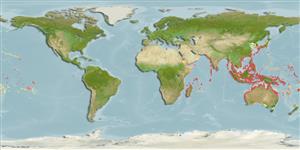Bivalvia |
Arcida |
Arcidae
Environment: milieu / climate zone / تغييرات عمق / distribution range
بوم شناسي
; لب شور; تغييرات عمق 0 - 20 m (مرجع 101198). Tropical, preferred 27°C (مرجع 107945); 46°N - 39°S, 26°E - 134°W (مرجع 106948)
Indo-Pacific.
Length at first maturity / Size / Weight / سن
بلوغ: Lm ?, range 2 - 2.1 cm Max length : 9.0 cm SHL جنس نر / بدون خواص جنسي; (مرجع 348); common length : 6.0 cm SHL جنس نر / بدون خواص جنسي; (مرجع 348); بيشينه سن گزارش شده: 12 سال ها (مرجع 126573)
Shell equivalve, thick and solid, ovate, strongly inflated, slightly longer than high and feebly inequilateral. Umbones strongly protruding, cardinal area rather large. About 18 radial ribs (15 to 20) with wide interstices at each valve; ribs stout and distinctly rugose, bearing regular, often rectangular nodules. Periostracum rather thin and smooth. Internal margins with strong crenulations corresponding with the external radial ribs. No byssal gape. Colour: outside of shell white under the yellowish brown periostracum. Inner side white, often tinged yellow towards the umbonal cavity.
This represents the most important commercial ark (Ref. 348). Lives in intertidal and shallow subtidal waters. On muddy bottoms, mainly in protected bays and estuaries, or in mangroves. Often occurring in dense populations (Ref. 348). Typically found in the intertidal with silty bottoms with low salinity. A filter-feeder and a shallow burrower. Primarily feeds on organic detritus, phytoplankton and detritus (Ref. 101198).
Life cycle and mating behavior
بلوغ | تولید مثل | تخم ریزی | Eggs | Fecundity | Larvae
Members of the class Bivalvia are mostly gonochoric, some are protandric hermaphrodites. Life cycle: Embryos develop into free-swimming trocophore larvae, succeeded by the bivalve veliger, resembling a miniature clam.
مآخذ اصلی
مراجع | هماهنگ كننده | همكاران
Poutiers, J.M. 1998 Bivalves. Acephala, Lamellibranchia, Pelecypoda. p. 123-362. In Carpenter, K. E. and V. H. Niem. 1998. FAO species identification guide for fishery purposes. The living marine resources of the Western Central Pacific. Volume 1. Seaweeds, corals, bivalves, and gastropods. Rome, FAO. (مرجع 348)
وضعيت در فهرست قرمز IUCN
(مرجع 130435: Version 2025-1)
وضعيت از نظر سايتس (مرجع 108899)
Not Evaluated
Not Evaluated
خطر برای انسان ها
Harmless
استفاده انسانی
ماهي گيري – شيلات: تجاري
FAO - آبزي پروري: production; ماهي گيري – شيلات: landings, نمايه گونه | FishSource | Sea Around Us
ابزارها
اطلاعات بيشتر
PhysiologyOxygen consumption
Human RelatedStamps, coins, misc.
منابع اينترنتي
Estimates based on models
Preferred temperature
(Ref.
115969): 21.8 - 29.3, mean 28.4 (based on 3701 cells).
جهندگی
زياد, كمينه زمان لازم براي دو برابر شدن جمعيت ، كمتر از 15 ماه (K=0.54-4.34; tm=0.6; tmax=12).
Prior r = 0.85, 95% CL = 0.56 - 1.28, Based on 2 data-limited stock assessments.
Fishing Vulnerability
Low to moderate vulnerability (28 of 100).
Climate Vulnerability
High vulnerability (61 of 100).
Nutrients : Calcium = 149 [71, 228] mg/100g; Iron = 8.53 [1.95, 15.11] mg/100g; Protein = 9.88 [8.64, 11.12] %; Omega3 = 0.313 [0.202, 0.423] g/100g; Selenium = 61 [50, 72] μg/100g; VitaminA = 0 μg/100g; Zinc = 2.04 [0.56, 3.51] mg/100g (wet weight); based on
nutrient studies.
